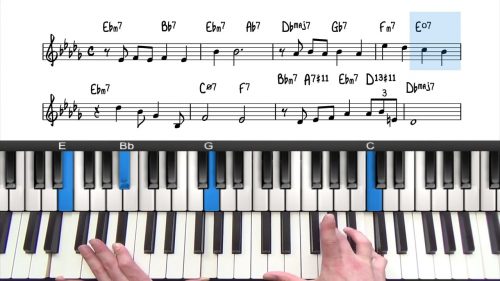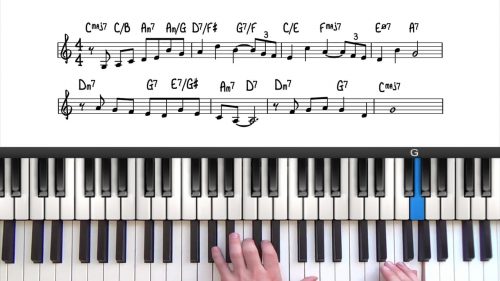Exploring “Body and Soul” – The A Section
Welcome to the 1st lesson on the jazz standard “Body and Soul” in our Novice section of jazz piano lesson. In this lesson, we will dive into the A section of the tune, focusing on understanding its harmonic structure and applying fundamental jazz piano voicing techniques.
Understanding The Form & Harmony
“Body and Soul” follows an AABA form, with the A section repeating 3 times with slight variations. We begin by examining the first eight bars of the song and we isolate the 7th chords in root position to familiarise ourselves with the harmonic framework.
The harmony include common jazz chord progressions such as 2-5s and 2-5-1s – it’s important to be able to recognise and navigate these common progressions.
Key of Db Major and 2-5-1 Progressions
The A sections of the tune are written in the key of Db major. The 2-5-1 progression, a fundamental building block in jazz harmony, appears twice in this section. First in bars 2 & 3 we have an Eb-7 chord (ii), moving to an Ab7 chord (V), and resolving to a Dbmaj7 chord (I), and again the same progression in bars 7 and 8 of the A section. This progression firstly establishes the tonal center of Db Major.
Root Position Chords and Spread Voicings
After playing through the chords in root position, we explore 2-handed spread voicings to achieve a smoother and more connected sound as we play through the chord changes. Spread voicings avoid overlapping our chord voicings with the melody and create a more balanced and open sound.
Spreading the notes of the 7th chords across both hands allows us to maintain the harmonic integrity of the song while providing more room for the melody to shine. For example, instead of playing all chord tones together, we might play the root and 5th in the left hand while placing the 3rd and 7th in the right hand, resulting in a more resonant and expressive voicing.
Incorporating Melodic Embellishments
As we progress, it’s important to recognise that the melody on a lead sheet serves as a guide rather than a strict directive. We can add embellishments, alter rhythms, and even modify phrasing to suit our interpretation. In this lesson, you’ll see some initial examples of how to start personalising the melody when you play jazz standards.
Putting It All Together
By the end of this lesson, you will be comfortable playing the A section with both root position chords and spread voicings. We also prepare for the next lesson, where we’ll combine both the 1st and 2nd A sections and begin to look at the transition into the the bridge (B section).
Practice Tips
-
Identify on 2-5-1 Progressions: Practice the 2-5-1 progression in Db major until you can smoothly transition between the chords.
-
Learn Spread Voicings: Play the 7th chords in both root position and then switch to 2-handed spread voicings to see the difference in sound and feel.
-
Visualise the Chords: As you play through the A section, try to visualise the diatonic 7th chords within the key of Db major.
-
Slow Practice: Start playing slowly, especially when adding the melody, to ensure clarity and smooth transitions.
-
Listen to Different Versions: Listen to various recordings of "Body and Soul" to understand how different artists interpret the melody and harmony. This will inspire your own embellishments.






